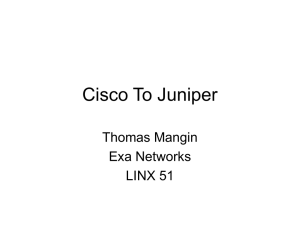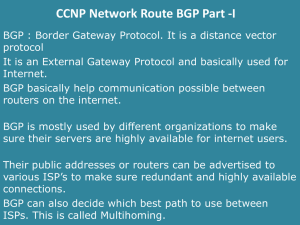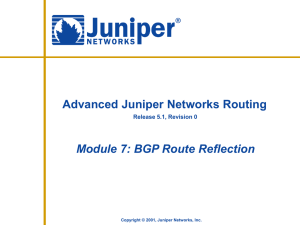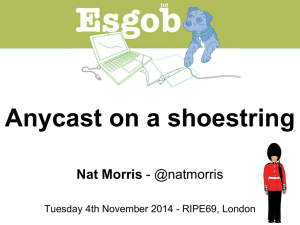lec7
advertisement
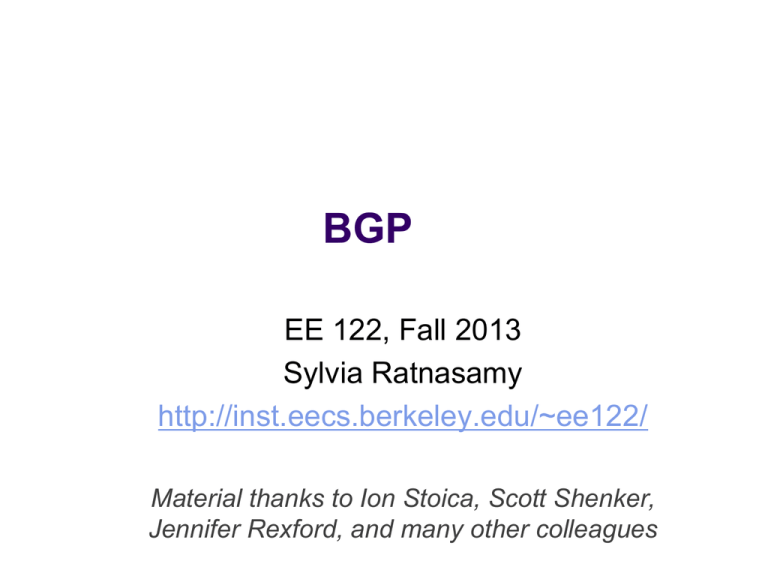
BGP EE 122, Fall 2013 Sylvia Ratnasamy http://inst.eecs.berkeley.edu/~ee122/ Material thanks to Ion Stoica, Scott Shenker, Jennifer Rexford, and many other colleagues BGP: The story so far Destinations are IP prefixes (12.0.0.0/8) Nodes are Autonomous Systems (ASes) Links represent both physical connections and business relationships customer-provider or peer-to-peer BGP path-vector protocol policy-driven route selection BGP: Today BGP policy typical policies, how they’re implemented BGP protocol details Issues with BGP Policy imposed in how routes are selected and exported Route export Route selection Customer 1 Can reach 128.3/16 blah blah 10 Competitor 5 Selection: Which path to use? controls whether/how traffic leaves the network Export: Which path to advertise? controls whether/how traffic enters the network Typical Selection Policy In decreasing order of priority make/save money (send to customer > peer > provider) maximize performance (smallest AS path length) minimize use of my network bandwidth (“hot potato”) … … Typical Export Policy Destination prefix advertised by… Export route to… Customer Everyone (providers, peers, other customers) Peer Customers Provider Customers We’ll refer to these as the “Gao-Rexford” rules (capture common -- but not required! -- practice!) Gao-Rexford providers peers customers With Gao-Rexford, the customer-provider graph is a DAG (directed acyclic graph) and routes are “valley free” BGP: Today BGP policy BGP protocol details typical policies, how they’re implemented stay awake as long as you can… BGP issues Who speaks BGP? Border router Internal router Border routers at an Autonomous System What does “speak BGP” mean? Implement the standardized BGP protocol Specifies what messages to exchange with other BGP “speakers” read more here: http://tools.ietf.org/html/rfc4271 message types: e.g., route advertisements message syntax: e.g., first X bytes for dest prefix; next Y for AS path, etc. And how to process these messages e.g., “when you receive a message of type X, apply this selection rule, then…” as per BGP state machine in the protocol spec + policy decisions, etc. BGP “sessions” “eBGP session” A border router speaks BGP with border routers in other ASes BGP “sessions” “iBGP session” A border router speaks BGP with other (interior and border) routers in its own AS eBGP, iBGP, IGP eBGP: BGP sessions between border routers in different ASes iBGP: BGP sessions between border routers and other routers within the same AS Learn routes to external destinations distribute externally learned routes internally assume a full all-to-all mesh of iBGP sessions IGP: “Interior Gateway Protocol” = Intradomain routing protocol provide internal reachability e.g., OSPF, RIP Some Border Routers Don’t Need BGP Customer that connects to a single upstream ISP The ISP can advertise prefixes into BGP on behalf of customer … and the customer can simply default-route to the ISP Provider Install routes 130.132.0.0/16 pointing to Customer Install default routes 0.0.0.0/0 pointing to Provider Customer 130.132.0.0/16 Putting the pieces together 6 2 3 4 3 1. 2. 3. 4. 9 1 Provide internal reachability (IGP) Learn routes to external destinations (eBGP) Distribute externally learned routes internally (iBGP) Travel shortest path to egress (IGP) 2 Basic Messages in BGP Open Notification Report unusual conditions Update Establishes BGP session BGP uses TCP [will make sense in 1-2weeks] Inform neighbor of new routes Inform neighbor of old routes that become inactive Keepalive Inform neighbor that connection is still viable BGP Operations Open session on TCP port 179 AS1 BGP session Exchange all active routes AS2 Exchange incremental Updates While connection is ALIVE exchange route UPDATE messages Route Updates Format <IP prefix: route attributes> attributes describe properties of the route Two kinds of updates announcements: new routes or changes to existing routes withdrawal: remove routes that no longer exist Route Attributes Routes are described using attributes Some attributes are local i.e., private within an AS, not included in announcements e.g., LOCAL PREF, ORIGIN Some attributes are propagated with eBGP route announcements Used in route selection/export decisions e.g., NEXT HOP, AS PATH, MED, etc. There are many standardized attributes in BGP We will discuss a few Attributes (1): ASPATH Carried in route announcements Vector that lists all the ASes a route announcement has traversed (in reverse order) e.g., “7018 88” AS 7018 AT&T AS 88 AS 12654 Princeton, 128.112/16 IP prefix = 128.112.0.0/16 AS path = 88 128.112.0.0/16 AS path = 7018 88 Attributes (2): NEXT HOP Carried in a route update message IP address of next hop router on path to destination Updated as the announcement leaves AS 192.0.2.1 AS 7018 12.127.0.121 AT&T AS 12654 AS 88 Princeton, 128.112/16 IP prefix = 128.112.0.0/16 AS path = 88 Next Hop = 192.0.2.1 128.112.0.0/16 AS path = 7018 88 Next Hop = 12.127.0.121 Attributes (3): LOCAL PREF “Local Preference” Used to choose between different AS paths The higher the value the more preferred Local to an AS; carried only in iBGP messages Ensures consistent route selection across an AS 140.20.1.0/24 BGP table at AS4: AS1 AS3 AS2 AS4 Destination AS Path Local Pref 140.20.1.0/24 AS3 AS1 300 140.20.1.0/24 AS2 AS1 100 Example: iBGP and LOCAL PREF Both routers prefer the path through AS 100 on the left AS1 AS 2 AS 3 Local Pref = 90 Local Pref = 100 I-BGP AS 4 Attributes (4): ORIGIN Records who originated the announcement Local to an AS Options: “e” : from eBGP “i” : from iBGP “?” : Incomplete; often used for static routes Typically: e > i > ? Attributes (5) : MED “Multi-Exit Discriminator” Used when ASes are interconnected via 2 or more links to specify how close a prefix is to the link it is announced on Lower is better AS announcing prefix sets MED (AS2 in picture) AS receiving prefix (optionally!) uses MED to select link (AS1 in pic.) AS1 Link B Link A MED=50 MED=10 AS2 AS3 destination prefix Attributes (6): IGP cost Used for hot-potato routing Each router selects the closest egress point based on the path cost in intra-domain protocol dst 3 D F 8 5 C hot potato 8 3 4 27 B 9 A E 10 4 G IGP may conflict with MED A Dsf NEXTHOP=SF MED=100 B NEXTHOP=BOS MED=500 Using Attributes Rules for route selection in priority order Priority Rule Remarks 1 LOCAL PREF Pick highest LOCAL PREF 2 ASPATH Pick shortest ASPATH length 3 MED Lowest MED preferred 4 eBGP > iBGP Did AS learn route via eBGP (preferred) or iBGP? 5 iBGP path Lowest IGP cost to next hop (egress router) 6 Router ID Smallest router ID (IP address) as tie-breaker BGP UPDATE Processing Open ended programming. Constrained only by vendor configuration language Receive Filter routes & BGP Updates tweak attributes Apply Import Policies Based on Attribute Values Best Route Selection Best Routes Best Route Table Apply Policy = filter routes & tweak attributes Apply Export Policies Install forwarding Entries for best Routes. IP Forwarding Table Transmit BGP Updates BGP: Today BGP policy typical policies, how they’re implemented BGP protocol details BGP issues Issues with BGP Reachability Security Convergence Performance Reachability In normal routing, if graph is connected then reachability is assured With policy routing, this does not always hold Provider AS 1 AS 3 AS 2 Customer Provider Security An AS can claim to serve a prefix that they actually don’t have a route to (blackholing traffic) Problem not specific to policy or path vector Important because of AS autonomy Fixable: make ASes “prove” they have a path Note: AS can also have incentive to forward packets along a route different from what is advertised Tell customers about fictitious short path… Much harder to fix! Convergence Result: If all AS policies follow “Gao-Rexford” rules, BGP is guaranteed to converge (safety) For arbitrary policies, BGP may fail to converge! Example of Policy Oscillation 130 “1” prefers “1 3 0” over “1 0” to reach “0” 1 0 1 0 210 20 36 2 3 320 30 Step-by-Step of Policy Oscillation Initially: nodes 1, 2, 3 know only shortest path to 0 130 10 1 0 210 20 37 2 3 320 30 Step-by-Step of Policy Oscillation 1 advertises its path 1 0 to 2 130 10 1 0 210 20 38 2 3 320 30 Step-by-Step of Policy Oscillation 130 10 1 0 210 20 39 2 3 320 30 Step-by-Step of Policy Oscillation 3 advertises its path 3 0 to 1 130 10 1 0 210 20 40 2 3 320 30 Step-by-Step of Policy Oscillation 130 10 1 0 210 20 41 2 3 320 30 Step-by-Step of Policy Oscillation 1 withdraws its path 1 0 from 2 130 10 1 0 210 20 42 2 3 320 30 Step-by-Step of Policy Oscillation 130 10 1 0 210 20 43 2 3 320 30 Step-by-Step of Policy Oscillation 2 advertises its path 2 0 to 3 130 10 1 0 210 20 2 3 advertise: 2 0 44 320 30 Step-by-Step of Policy Oscillation 130 10 1 0 210 20 45 2 3 320 30 Step-by-Step of Policy Oscillation 3 withdraws its path 3 0 from 1 130 10 1 0 210 20 46 2 3 320 30 Step-by-Step of Policy Oscillation 130 10 1 0 210 20 47 2 3 320 30 Step-by-Step of Policy Oscillation 1 advertises its path 1 0 to 2 130 10 1 0 210 20 48 2 3 320 30 Step-by-Step of Policy Oscillation 130 10 1 0 210 20 2 3 320 30 Step-by-Step of Policy Oscillation 2 withdraws its path 2 0 from 3 130 10 1 0 210 20 2 3 withdraw: 2 0 50 320 30 Step-by-Step of Policy Oscillation 130 10 1 0 210 20 51 2 3 320 30 We are back to where we started! Convergence Result: If all AS policies follow “Gao-Rexford” rules, BGP is guaranteed to converge (safety) For arbitrary policies, BGP may fail to converge! Should this trouble us? Performance Nonissues Internal routing (non) Policy not about performance (non) Domains typically use “hot potato” routing Not always optimal, but economically expedient So policy-chosen paths aren’t shortest Choosing among policy-compliant paths (non) Fewest AS hops has little to do with actual delay 20% of paths inflated by at least 5 router hops Performance (example) AS path length can be misleading An AS may have many router-level hops BGP says that path 4 1 is better than path 3 2 1 AS 4 AS 3 AS 2 AS 1 Real Performance Issue: Slow convergence BGP outages are biggest source of Internet problems Labovitz et al. SIGCOMM’97 Labovitz et al. SIGCOMM 2000 10% of routes available less than 95% of time Less than 35% of routes available 99.99% of the time 40% of path outages take 30+ minutes to repair But most popular paths are very stable BGP Misconfigurations BGP protocol is both bloated and underspecified lots of leeway in how to set and interpret attribute values, route selection rules, etc. necessary to allow autonomy, diverse policies but also gives operators plenty of rope Much of this configuration is manual and ad hoc And the core abstraction is fundamentally flawed per-router configuration to effect AS-wide policy now strong industry interest in changing this! [later: SDN] BGP: How did we get here? BGP was designed for a different time before commercial ISPs and their needs before address aggregation before multi-homing • don’t 1989 :get BGP-1 [RFC 1105] We a second chance: `clean slate’ – Replacement EGP (1984, RFC designs virtually for impossible to 904) deploy • 1990 : BGP-2 [RFC 1163] • 1991 experiment: : BGP-3 [RFC 1267] Thought how would you design a • 1995 : BGP-4 [RFC 1771]routing solution? How policy-driven interdomain Support for Classless would– you deploy it? Interdomain Routing (CIDR) Next Time. Wrap up the network layer! the IPv4 header IP routers
